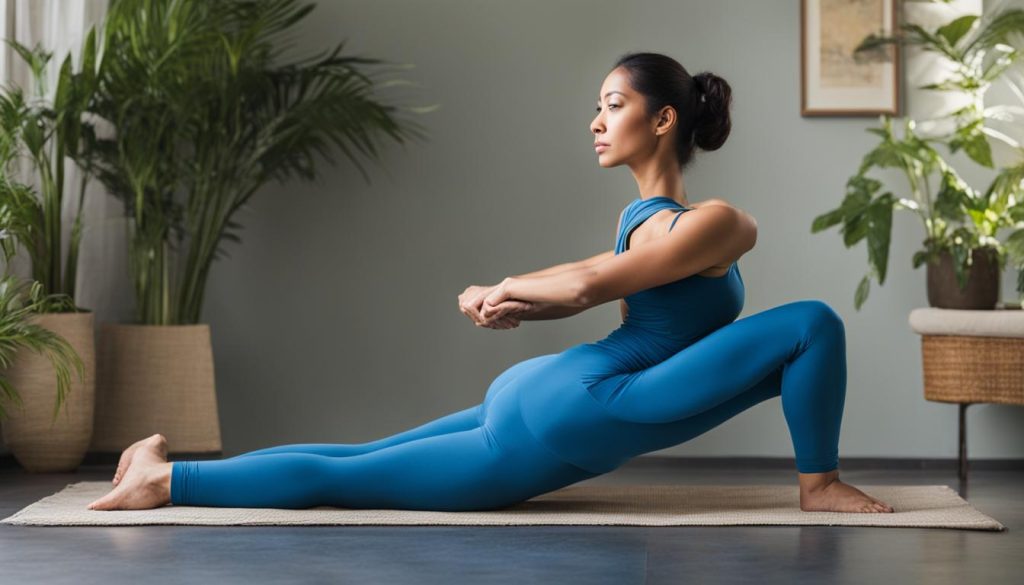Dealing with lower back pain can be frustrating and limiting. Whether it’s caused by a sedentary lifestyle or muscle strain, finding relief is essential for improving your quality of life. One effective approach to tackle lower back pain is through targeted stretches and exercises that focus on strengthening and stretching the muscles in this area.
By incorporating specific stretches into your daily routine, you can help alleviate discomfort, improve flexibility, and promote overall back health. From gentle stretches to more advanced exercises, there are various options to consider based on your comfort level and specific needs.
Discover Stretches For Lower Back Pain
- Stretching exercises can provide relief and improve flexibility in the lower back.
- Consult with a doctor before starting any stretching routine, especially if you have underlying health concerns.
- Understanding the causes of your lower back pain can help tailor your stretching routine.
- Child’s Pose and knee-to-chest stretches are effective for targeting the lower back.
- Piriformis stretches and seated spinal twists can help alleviate tension in the buttocks and improve lower back mobility.
Understanding Lower Back Pain and Its Causes
Lower back pain can be a common and debilitating issue, affecting people of all ages and lifestyles. It is often caused by a combination of factors, including underlying medical conditions and lifestyle choices. By understanding the causes of lower back pain, you can better tailor your stretching routine to address your specific needs and find relief.
There are several underlying conditions that can contribute to lower back pain. For example, kidney stones and acute pancreatitis can cause severe pain in the lower back region. Other medical conditions, such as herniated discs, arthritis, or spinal stenosis, can also lead to discomfort in the lower back.
In addition to medical conditions, certain lifestyle choices can increase the risk of lower back pain. Sedentary habits, such as sitting for prolonged periods, can weaken the muscles in the lower back and contribute to pain. Repetitive motions, such as lifting heavy objects or bending over frequently, can strain the muscles in the back and lead to discomfort. Muscle strain from sudden movements or overexertion can also cause lower back pain.
When experiencing lower back pain, it is important to consider these underlying causes. By identifying the specific factors contributing to your pain, you can develop a targeted stretching routine that addresses your unique needs. Consulting with a healthcare professional is advisable to determine any underlying conditions and receive appropriate treatment recommendations.
Important Considerations Before Starting Stretching
Before embarking on any stretching routine, especially if you have a recent injury or underlying health condition, it’s crucial to consult with a doctor. They can provide expert guidance on which stretches are safe and appropriate for your specific situation, considering any precautions and contraindications.
Consulting with a doctor is essential because they have the knowledge and expertise to evaluate your condition comprehensively and determine the optimal approach to stretching for your lower back pain. They can help identify any specific precautions you need to take based on your individual circumstances.
Listening to your body and understanding its limitations is also key. Approaching stretching with caution is important to avoid exacerbating any existing pain or discomfort. Pushing yourself too hard or exceeding your body’s limits can lead to further injury or strain.
Remember that stretching is a form of exercise and, like any exercise, it’s important to start slowly and gradually increase intensity and duration over time. Rome wasn’t built in a day, and neither is stretching progress. Consistency and patience are key factors in achieving long-term relief and flexibility.
By taking these important considerations into account, you can approach your stretching routine with confidence, knowing that you are prioritizing your safety and well-being.
- Consult with a doctor before starting any new stretching routine.
- Follow professional advice on safe and appropriate stretches for your condition.
- Take into consideration any precautions or contraindications.
- Listen to your body and avoid overexertion or pushing past your limits.
- Start slowly and gradually increase intensity and duration over time.
- Be consistent and patient in your stretching routine for long-term relief.
Child’s Pose: A Gentle Stretch for Lower Back Relief
Child’s Pose is a traditional yoga pose that offers a gentle stretch for the lower back, making it an excellent relaxation pose for those experiencing lower back pain. This pose is widely recognized for its ability to provide relief and ease tension in the spine, neck, and shoulders.
When in the Child’s Pose, the body rests in a kneeling position with the hips positioned back towards the heels, and the forehead touching the floor or a yoga mat. This posture promotes a gentle elongation of the gluteus maximus, latissimus dorsi, and spinal extensor muscles, all of which contribute to spinal health and flexibility in the lower back.
The Child’s Pose is an accessible and beginner-friendly posture that can be incorporated into your stretching routine to alleviate lower back pain and promote relaxation. To perform this stretch, follow these steps:
- Kneel on the floor with your knees hip-width apart.
- Sit back towards your heels, keeping your toes together and heels slightly apart.
- Lower your torso between your thighs and extend your arms in front of you with palms facing down.
- Rest your forehead on the floor or a yoga mat.
- Breathe deeply and hold the pose for 1-3 minutes, focusing on releasing tension in your lower back.
During the Child’s Pose, it’s crucial to listen to your body and adjust as needed. If you experience discomfort or strain, consider using props such as a bolster or folded blanket to support your forehead or knees.
Incorporating the Child’s Pose into your stretching routine can enhance your overall well-being and provide relief from lower back pain. Remember, consistency is key when practicing any stretching exercises. Start with a duration that feels comfortable for you, and gradually increase the time as your flexibility improves over time.
So, whenever you feel the need for a gentle stretch and lower back relaxation, embrace the Child’s Pose and support your overall lower back health.
Knee-to-Chest Stretch: Targeting the Hips, Thighs, and Glutes
The knee-to-chest stretch is an effective way to relax and stretch the hips, thighs, and glutes while promoting overall relaxation. This stretch specifically targets these muscle groups, helping to relieve tension and tightness in the lower back.
To perform the knee-to-chest stretch, follow these steps:
- Lie on your back with both legs extended.
- Bend one knee and bring it towards your chest.
- Hold the knee with both hands and gently pull it closer to your chest.
- You should feel a gentle stretch in the hips, thighs, and glutes.
- Hold the stretch for 20-30 seconds, breathing deeply and relaxing into the stretch.
- Repeat the stretch on the other side.
Adding the knee-to-chest stretch to your stretching routine can help improve flexibility and relieve tension in the lower back. Remember to perform the stretch in a comfortable and controlled manner, avoiding any pain or discomfort. If you have any underlying health concerns or injuries, it’s advisable to consult with a healthcare professional before attempting this stretch.
Piriformis Stretch: Relieving Buttocks and Lower Back Tension
The piriformis stretch is an effective exercise for targeting the deep muscles of the buttocks and relieving tension in the lower back. When these muscles are tight, they can contribute to lower back pain and discomfort. By incorporating the piriformis stretch into your routine, you can improve flexibility and find relief from discomfort in these areas.
To perform the piriformis stretch, begin by lying on your back with both knees bent. Place one ankle on the opposite thigh, just above the knee. Gently pull the thigh towards your chest until you feel a stretch in the buttocks and lower back. Hold this position for 30 seconds to 1 minute, focusing on deep breathing and relaxation. Repeat the stretch on the other side.
The piriformis stretch can be done daily or as part of your stretching routine. It is important to listen to your body and avoid any pain or discomfort during the stretch. Gradually increase the intensity of the stretch over time, but never push yourself beyond your limits. Consistency is key for achieving the best results.
In addition to relieving tension in the buttocks and lower back, the piriformis stretch can also help improve hip flexibility and prevent injuries. It is a simple yet effective exercise that can be done in the comfort of your own home or at the gym.
Remember, if you have any existing health conditions or concerns, it is always best to consult with a healthcare professional before starting any new exercise routine.
Seated Spinal Twist: Enhancing Lower Back Mobility
The seated spinal twist is a classic stretch that targets the hips, glutes, and back. It increases mobility in the spine and stretches the abdominals, shoulders, and neck. This stretch can also stimulate the internal organs.
To perform the seated spinal twist, sit on the floor with both legs extended in front of you and twist your upper body to the side, using your arm for support. This motion allows for a deep stretch in the lower back, promoting flexibility and relieving tension.
Incorporating the seated spinal twist into your stretching routine can enhance lower back mobility and contribute to overall spinal health and well-being. It’s an effective way to relieve stiffness and discomfort while improving flexibility and range of motion in the lower back.
Remember to approach this stretch gently, being mindful of any limitations or pain. Listen to your body and only go as far as feels comfortable. If you have any pre-existing conditions or concerns, consult with a healthcare professional before attempting this stretch.
Try adding the seated spinal twist to your daily stretching routine and experience the benefits of increased lower back mobility and improved spinal health.

Conclusion
Effective stretches for lower back pain can provide much-needed relief and promote overall lower back health. By incorporating targeted stretching exercises into your daily routine, you can reduce discomfort, improve flexibility, and enhance your overall well-being.
However, it’s important to approach stretching with caution, especially if you have underlying conditions or concerns. Consulting with a healthcare professional is vital to ensure that the stretches you choose are safe and appropriate for your specific situation.
Remember, prioritizing self-care and listening to your body are key components on your journey to finding relief from lower back pain and improving mobility. By investing in regular stretching exercises, you can take proactive steps towards a healthier and pain-free lower back. So, let’s unlock the benefits of stretching and embrace a life of greater comfort and flexibility!
FAQ
What are some effective stretches for lower back pain?
Some effective stretches for lower back pain include Child’s Pose, the knee-to-chest stretch, the piriformis stretch, and the seated spinal twist. These stretches target different areas of the lower back and can help provide relief and improve flexibility.
What are the causes of lower back pain?
Lower back pain can be caused by various factors, including a sedentary lifestyle, muscle strain, repetitive motions, and underlying conditions such as kidney stones or acute pancreatitis.
Is it important to consult with a doctor before starting a stretching routine for lower back pain?
Yes, it is important to consult with a doctor before starting any new exercise routine, especially if you have a recent injury or underlying health condition. They can provide guidance on which stretches are safe and appropriate for your specific situation.




